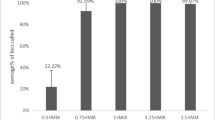Abstract
The aim of the present work was to improve the discriminatory potential, and hence the probative value, of Y-STR-based testing by extending the set of Y chromosome STR loci available for forensic casework. In accordance with the requirements of a Y chromosome multiplex analytical system developed specifically for forensic casework use, we have sought to maximize the number of loci able to be co-amplified, ensure appropriate assay sensitivity (1–2 ng of input genomic DNA), balance inter-locus signals and minimize confounding female DNA artifacts.
Two Y chromosome STR systems, multiplex I (MPI) and multiplex II (MPII), have been developed which permit the robust co-amplification of 18 Y-STRs. The loci include DYS19, DYS385(a) and (b), DYS388, DYS389I and II, DYS390, DYS391, DYS392, DYS393, DYS425, DYS434, DYS437, DYS438, DYS439, Y-GATA-C4, Y-GATA-A7.1 (DYS460) and Y-GATA-H4. The two multiplex systems are robust over a wide range of primer, magnesium, and DNA polymerase concentrations and perform well under a variety of cycling conditions. Complete male haplotypes can be obtained with as little as 100–250 pg of template DNA. Although a limited number of female DNA artifacts are observed in mixed stains in which the male DNA comprises 1/100 of the total, the male profile is easily discernible. Slightly modified versions of MPI and MPII demonstrate a significant reduction in female artifacts. Thus, it may not be necessary to employ a differential extraction strategy to obtain a male haplotype (or haplotypes in the case of multiple male donors) in cases of sexual assault. The potential utility of MPI and MPII for forensic casework is exemplified by their ability to dissect out the male haplotype in post-coital vaginal swabs and to determine the number of male donors in mixed semen stains.
This study has emphasized the need for novel Y-STR multiplexes developed for forensic use to undergo a series of validation exercises that go beyond simply optimizing the PCR reaction conditions. Specifically, stringent performance checks on their efficacy need to be carried out using casework-type specimens in order to determine potential confounding effects from female DNA.









Similar content being viewed by others
References
Justice Statistics Bureau of (2001) US Department of Justice, Washington DC, p 1–110
Lahn BT, Page DC (1997) Science 278:675–680
Lahn BT, Pearson NM, Jegalian K (2001) Nat Rev Genet 2:207–216
Sykes B, Irven C (2000) Am J Hum Genet 66:1417–1419
Jobling MA (2001) Trends Genet 17:353–357
Kayser M, Caglia A, Corach D, Fretwell N, Gehrig C, Graziosi G, Heidorn F, Herrmann S, Herzog B, Hidding M, Honda K, Jobling M, Krawczak M, Leim K, Meuser S, Meyer E, Oesterreich W, Pandya A, Parson W, Penacino G, Perez-Lezaun A, Piccinini A, Prinz M, Schmitt C, Roewer L, et al (1997) Int J Legal Med 110:125–133
Kayser M, de Knijff P, Dieltjes P, Krawczak M, Nagy M, Zerjal T, Pandya A, Tyler-Smith C, Roewer L (1997) Electrophoresis 18:1602–1607
Ayub Q, Mohyuddin A, Qamar R, Mazhar K, Zerjal T, Mehdi SQ, Tyler-Smith C (2000) Nucleic Acids Res 28:e8
White PS, Tatum OL, Deaven LL, Longmire JL (1999) Genomics 57:433–437
Jobling MA (2001) Forensic Sci Int 118:158–162
Jobling MA, Heyer E, Dieltjes P, de Knijff P (1999) Hum Mol Genet 8:2117–2120
Weber JL, May PE (1989) Am J Hum Genet 44:388–396
Schneider PM, Meuser S, Waiyawuth W, Seo Y, Rittner C (1998) Forensic Sci Int 97:61–70
Butler JM, Schoske R, Vallone PM, Kline MC, Redd AJ, Hammer MF (2002) Forensic Sci Int 129:10–24
Thomas MG, Bradman N, Flinn HM (1999) Hum Genet 105:577–581
Prinz M, Ishii A, Coleman A, Baum HJ, Shaler RC (2001) Forensic Sci Int 120:177–188
Bosch E, Lee AC, Calafell F, Arroyo E, Henneman P, de Knijff P, Jobling MA (2002) Forensic Sci Int 125:42–51
Kayser M, Brauer S, Willuweit S, Schadlich H, Batzer MA, Zawacki J, Prinz M, Roewer L, Stoneking M (2002) J Forensic Sci 47:513–519
Roewer L, Krawczak M, Willuweit S, Nagy M, Alves C, Amorim A, Anslinger K, Augustin C, Betz A, Bosch E, Caglia A, Carracedo A, Corach D, Dekairelle AF, Dobosz T, Dupuy BM, Furedi S, Gehrig C, Gusmao L, Henke J, Henke L, Hidding M, Hohoff C, Hoste B, Jobling MA, Kargel HJ, de Knijff P, Lessig R, Liebeherr E, Lorente M, Martinez-Jarreta B, Nievas P, Nowak M, Parson W, Pascali VL, Penacino G, Ploski R, Rolf B, Sala A, Schmidt U, Schmitt C, Schneider PM, Szibor R, Teifel-Greding J, Kayser M (2001) Forensic Sci Int 118:106–113
Jobling MA, Samara V, Pandya A, Fretwell N, Bernasconi B, Mitchell RJ, Gerelsaikhan T, Dashnyam B, Sajantila A, Salo PJ, Nakahori Y, Disteche CM, Thangaraj K, Singh L, Crawford MH, Tyler-Smith C (1996) Hum Mol Genet 5:1767–1775
Comey CK, Koons BW, Presley KW, Smerick JB, Sobieralski CA, Stanley DM, Baechtel FS (1994) J Forensic Sci 39:1254–1269
Gill P, Jeffreys AJ, Werrett DJ (1985) Nature 318:577–579
Walsh PS, Varlaro J, Reynolds R (1992) Nucleic Acids Res 20:5061–5065
Robertson JM, Sgueglia JB, Badger CA, Juston AC, Ballantyne J (1995) Electrophoresis 16:1568–1576
Walsh PS, Fildes NJ, Reynolds R (1996) Nucleic Acids Res 24:2807–2812
University of Central Florida (2000) Orlando
Butler J (2000) Eleventh international symposium on human identification, Biloxi, MS
Acknowledgements
The authors gratefully acknowledge the financial support of the National Institute of Justice and the State of Florida. The authors are also appreciative of a donation from the Bode Technology Group, VA at the early stages of this project.
Author information
Authors and Affiliations
Corresponding author
Rights and permissions
About this article
Cite this article
Hall, A., Ballantyne, J. The development of an 18-locus Y-STR system for forensic casework. Anal Bioanal Chem 376, 1234–1246 (2003). https://doi.org/10.1007/s00216-003-2039-2
Received:
Revised:
Accepted:
Published:
Issue Date:
DOI: https://doi.org/10.1007/s00216-003-2039-2




